Our editors independently select these products. Making a purchase through our links may earn Well+Good a commission
Spruce Up Your Living Space With These 12 Expert-Approved Indoor Trees
From easy-going palms to fussy (but beautiful) fruit-bearers, spruce up your living space with an expert-approved indoor tree.

Plot twist: Just because you don’t have a big backyard or spacious patio doesn’t mean you have to be stuck growing the same, usual suspects of indoor houseplants. Not that we’ll ever turn down a sturdy snake plant or trailing string of pearls—Rather, with just a smidge of space inside your home, you can bring the outdoors in with some tall, lush indoor trees.
Experts in This Article
Caroline Copeland is a design expert at online custom landscape design platform, Yardzen.
Matthew Witemyre teaches landscape horticulture at Merritt College Oakland in California.
Now, just like other popular houseplants, you’ll need to consider the conditions of the place you’ve chosen for your trusty new tree friend before you buy. The best indoor trees will thrive in the right settings, with the right care. “You’ll need to assess the light exposure of the location you’re aiming to fill, as well as how often you’re able to water the plant,” says Caroline Copeland, a design expert at online custom landscape design platform Yardzen. “Most indoor trees will prefer partial direct sun or very bright indirect light.”
Make sure to choose a tree with care requirements you’re willing to meet. Some trees can do well indoors simply with the right setting and some watering only every couple of weeks. Other, more finicky trees (cough cough, the fiddle-leaf fig!) need more attention. These require more water, more misting, and more overall care.
Matt Witemyre, who teaches in the landscape horticulture department at Merritt College Oakland in California, echoed Copeland’s advice about indoor trees needing more light, but added, “You can grow any tree indoors if you slowly acclimate it.”
If you’re ready to go out on a limb (lol) and invest in an indoor tree, you’ve come to the right spot. Below, we’ve rounded up expert-approved indoor trees that’ll spruce up any space, complete with care instructions, pet-friendliness, and how tall they can grow. No more beating around the bush—scroll to shop, below.
Best Indoor Trees

Rubber Tree (Ficus elastica) — $65.00
Difficulty level for care: EasyIdeal conditions: Partial direct sun or very bright indirect light; water every two weeks; ideal temperature 60–80°FMaximum height: 6–10 feetPet-friendly: No
The rubber tree, recommended by both Copeland and Witemyre, is related to the fiddle-leaf fig (which The New York Times recently labeled a “former ‘It’ plant”), but is easier to care for, according to Copeland. She shared a tip about how to best water a rubber tree. “To ensure sufficient water absorption, aerate the soil by gently inserting a chopstick before each watering. This tip can be applied to any plant to maintain a healthy environment for the roots.”
Pictured is the burgundy rubber tree, but Copeland says the rubber tree is also available in white, yellow, pinks, and light green. This tree arrives in a grower pot.
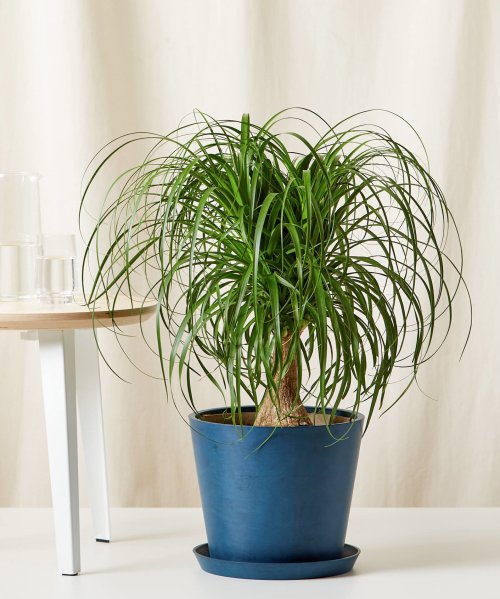
Ponytail Palm (Beaucarnea recurvata) — $149.00
Difficulty level for care: Very easyIdeal conditions: Bright light; water every two weeks; ideal temperature 70–80°FMaximum height: Up to 10 feet indoorsPet-friendly: Yes; nontoxic to cats and dogs
If you’re looking for a low-maintenance, eye-catching indoor tree, the ponytail palm (also called the “elephant’s foot”) could be for you. These tangly trees are super simple to care for—although, if you tend to be an impatient person regarding caring for plants, you may want to skip owning one. “Ponytail palms grow very slowly, so I would suggest grabbing the biggest size you can find. This slow growth can be a benefit if you don’t plan on learning how to prune anytime soon,” Copeland says.
Wait a while, though, and you’ll be rewarded with a striking plant. “I’ve got a 6-foot-tall one in my apartment and it looks incredible,” Witemyre says. Or fast forward and buy this large ponytail palm from Bloomscape instead, which comes in five different colored pots that’ll jazz up your living room.

Bird of Paradise (Strelitzia nicolai) — $98.00
Difficulty level for care: EasyIdeal conditions: Bright, direct light (at least six hours); water thoroughly every two weeks (plus mist occasionally); ideal temperature 50–70°FMaximum height: 10 feet and upPet-friendly: No
If you’ve got a super sunny spot in your home and want to add a tropical vibe, consider a Bird of Paradise. “If you’re looking to place a tree in an area of your house that receives more than six hours of sunlight per day, a Strelitzia … is the way to go,” Copeland says. She shared that a related species, Strelitzia reginae, is a more manageable option, so if you don’t exactly have a green thumb, it may be a better choice.
But if you do go with this tropical tree, Copeland suggests wiping the leaves clean with a wet cloth every few week because Bird of Paradise are susceptible to harmful spider mites.
Plant e-retailer, The Sill, sells a variety of sizes of Bird of Paradise plants, including a large-and-in-charge beauty for $98.
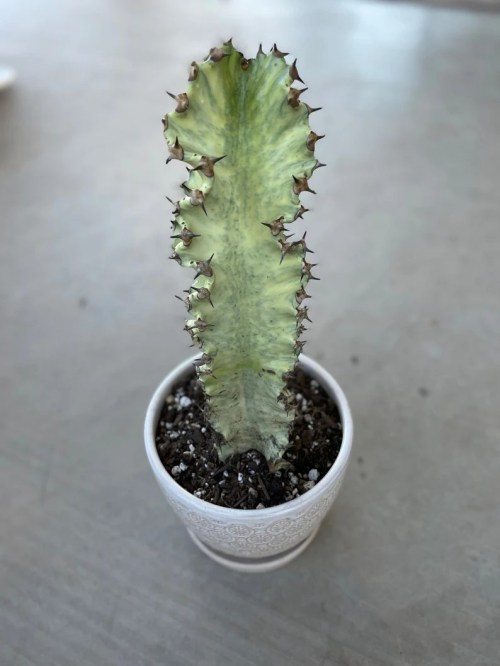
Candelabra Spurge (Euphorbia ammak var. Variegata) — $68.00
Difficulty level for care: EasyIdeal conditions: Ample sunlight; very little water (water every four to six weeks, depending on size); ideal temperature 65–85°FMaximum height: 15–20 feet outdoorsPet-friendly: No
Living a pet-free life? Copeland recommends checking out the candelabra spurge. “For those who leave home for extended periods of time—or are just forgetful about watering—I would suggest a Euphorbia ammak variegata,” she says. “This cactus-like plant needs to be fully dry before being watered again.”
Just note—it’s not OK for pets to munch on, and it’s also unpleasant to bump into, as Copeland explains. “Be aware that most Euphorbias have spines, so this is not a good option if you have young children or pets in your home,” she says.
This tree will arrive without soil or a pot—so you should have one ready when you order—and will measure at least 14 inches.

Song of India (Dracaena reflexa) — $69.00
Difficulty level for care: EasyIdeal conditions: Bright indirect light; water with with filtered, room-temperature water and let the top 1–2 inches dry out before watering; ideal temperature 65–80°FMaximum height: At least 15 feetPet-friendly: No
YPottery Barn doesn’t only sell faux plants, but live ones, too.
Copeland shared a couple of care tips for this tree—beyond ensuring proper light. “Minerals in our tap water, such as chlorine, cause build up in Dracaena’s leaves, which crisp up the edges.” She adds, “Check for mealy bugs that like to hide in the crevices of this impressive plant.” (According to the University of Maryland Extension, you can carefully use rubbing alcohol to rid the tree of these bugs.)
Copeland also provided a more aesthetic recommendation. “Removing the lower leaves can show off its intricate trunk and won’t hurt the plant so long as you don’t take off more than a third of the overall leaf mass,” she says.
This tree is available in 4-inch and 6-inch sizes in white, black, and terra-cotta pots. Expect it to grow only 3 to 4 inches a year.
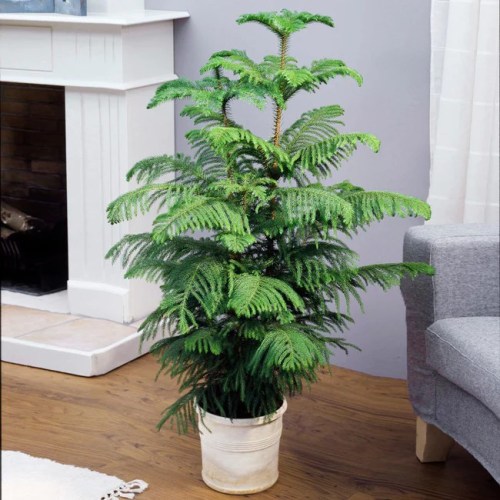
Norfolk Island Pine (Araucaria heterophylla) — $100.00
Difficulty level for care: EasyIdeal conditions: Partial sun ideally, but can tolerate low light; water and mist tree weekly; ideal temperature of 55–65°FMaximum height: 2–5 feet indoorsPet-friendly: No
Witemyre shared an enthusiastic recommendation for Norfolk island pines as indoor trees. “Norfolk Island pine is a fantastic plant to grow indoors—super easy and gets large, and [unlike most trees] can actually handle low light,” he says.
Fun fact: While this tree has “pine” in its name, the Norfolk Island pine isn’t a real pine tree. (Even though it looks like one to anyone who isn’t a tree expert.) It is, however, from Norfolk Island in the Pacific Ocean.
This tree is available in two heights: 2–3 feet and 3–4 feet.
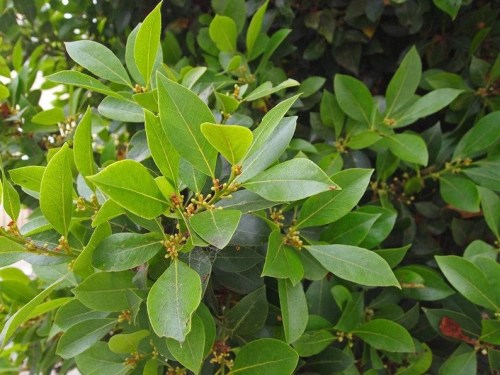
Sweet Bay (Laurus nobilis) — $22.00
Difficulty level for care: Easy to mediumIdeal conditions: Full sun to partial shade; water twice a week; ideal temperature 60–80°FMaximum height: Indoors, usually pruned to 4–6 feetPet-friendly: No
Laurus nobilis is one of the plants we get bay leaves from, so if you like to cook, you’ll enjoy having access to fresh bay leaves. You’ll find that fresh leaves have a stronger flavor than the dry ones you buy at the store. (By the way, if you’ve never cooked with bay leaves, make sure to take the leaf out before serving the dish.)
“You can grow a Laurus nobilis as long as you acclimate them to low-light conditions over time,” says Witemyre. If you’re not willing to do that, or you’d rather have a beginner-level indoor tree, he recommends simply displaying some sweet bay cuttings in a vase instead. This 1-foot tree from Etsy will arrive in a 6-inch pot.
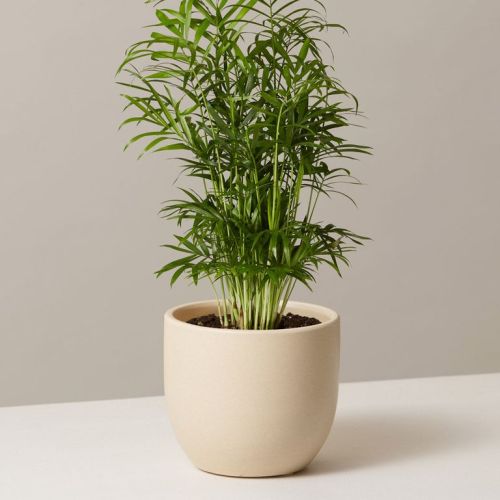
Parlor Palm (Chamaedorea elegans) — $47.00
Difficulty level for care: EasyIdeal conditions: Medium to bright indirect light; water every one to two weeks; ideal temperature 65–75°FMaximum height: 2–6 feet indoorsPet-friendly: Yes
Chamaedorea elegans, recommended by Witemyre as an indoor tree, probably has one of the fanciest-sounding tree scientific names. Besides parlor palm, its other nickname is bamboo palm, due to its bamboo-like stems. This tree’s flowers produce fruit, but unfortunately, they’re only good for looking at, not eating.
Note that a parlor palm shouldn’t be repotted (in other words, transferred to a larger container) more than every 2-3 years—but it grows very slowly. You can buy two different sizes of palms from The Sill: small ($48) and large ($180). It comes in four types of containers (including an up-cycled option) in two different sizes, 5 inches and 12 inches.

Ti Plant (Cordyline terminalis) — $110.00
Difficulty level for care: Easy to mediumIdeal conditions: Bright, indirect light; keep soil moist and mist tree frequently; fertilize regularly; ideal temperature of 65–95°FMaximum height: 3–5 feet indoorsPet-friendly: No
The Ti plant is also called the cabbage plant, palm lily, and good luck plant—and yes, it’s supposed to bring you good luck. And luckily for newbie plant parents, this tree is easy to care for. Some cultures have used the Ti plant for religious purposes, and it has many other uses.
The Ti plant is a great choice if you want to add some tropical vibes to your home. (Fun fact: In Hawaii, its leaves are used to make leis and hula skirts.)
This extra large Cordyline terminalis from Lively Root is available in a grower planter, eco pot planter, and basket planter, and looks gorgeous in bright, indirect light.
Best Indoor Fruit Trees

Calamondin bush (Citrus mitis) — $80.00
Difficulty level for care: MediumIdeal conditions: 6 to 8 hours of bright sunlight; allow the top 1–2 inches of soil to dry between waterings (and mist daily; consider a humidifier), use citrus fertilizer; ideal temperature 65–80°FMaximum size: 3–4 feet indoorsPet-friendly: No
While Witemyre says that, “citrus is usually pretty tough indoors” in general, he also shared that a Calamondin bush may still flower or fruit indoors.
The fruit you find on a Calamondin is usually called a “mini orange” and is a cross between a mandarin orange and a kumquat. The bush can produce fruit the first or second year, and the mini orange is a great choice for making marmalades and marinades as well as juicing, cooking, and baking (including flavoring cakes!).
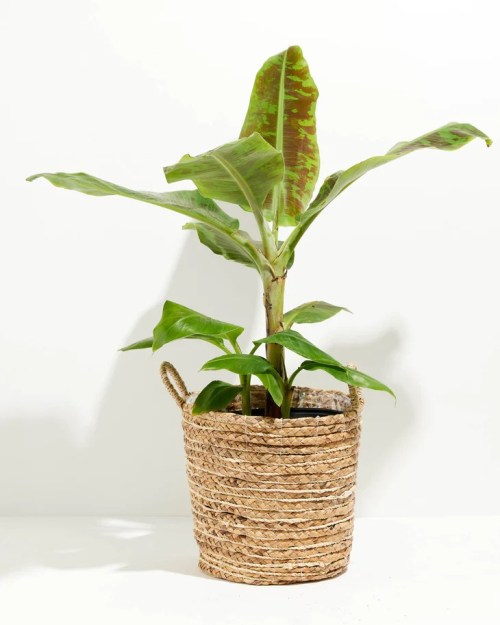
Musa Dwarf Cavendish Banana (Musa acuminata) — $50.00
Difficulty level for care: MediumIdeal conditions: 6–12 hours of direct sun; water consistently to prevent soil from drying (and consider a humidifier); ideal temperature 75–80+°FMaximum height: 6 feetPet-friendly: Yes; nontoxic to cats and dogs
Bananas inside your home? It’s true! David Angelov, the founder, CEO, and garden master at Plant Parenthood, recommends the banana tree for indoors, but notes that it needs a lot of water and that its pot must have adequate drainage. “The roots rot easily without proper airflow in the pot,” he says.
Banana trees thrive in hot and humid conditions, so if you love cranking up the air conditioning in the summertime to a level your guests call “freezing,” you should probably choose another tree. (If you don’t have AC, well, here’s a silver lining for living in a very warm home.)
Lively Root offers this banana tree in sizes medium to extra large in a grower planter, eco pot planter, and basket planter.
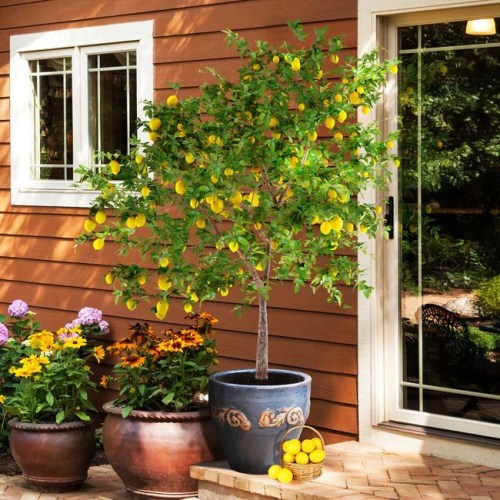
Meyer Lemon Tree (Citrus × meyeri 'Improved') — $30.00
Difficulty level for care: Medium to difficultIdeal conditions: More than 10 hours of day of bright light; water; ideal temperature of 50–80°FMaximum height: 8 feetPet-friendly: No
Angelov recommends the lemon tree as a good choice for an indoor tree, saying that it,“serves a dual purpose: [It] bears fruit and brings beautiful foliage. All of this, right in your living room or bedroom—or even the bathroom, if you have windows.”
Just note, you’ll have to be a little patient and not expect homegrown Meyer lemons immediately. One to four years is a likely time frame. This tree is available in four heights that range from 1–2 feet to 5–6 feet.
Want to be the first to hear about the latest (and greatest) SHOP product drops, custom collections, discounts, and more? Sign up to have the intel delivered straight to your inbox.
Sign up for the Well+Good SHOP Newsletter
Get exclusive deals on wellness, beauty, fitness, and food products that have been hand-picked by our editors.
Got it, you've been added to our email list.









